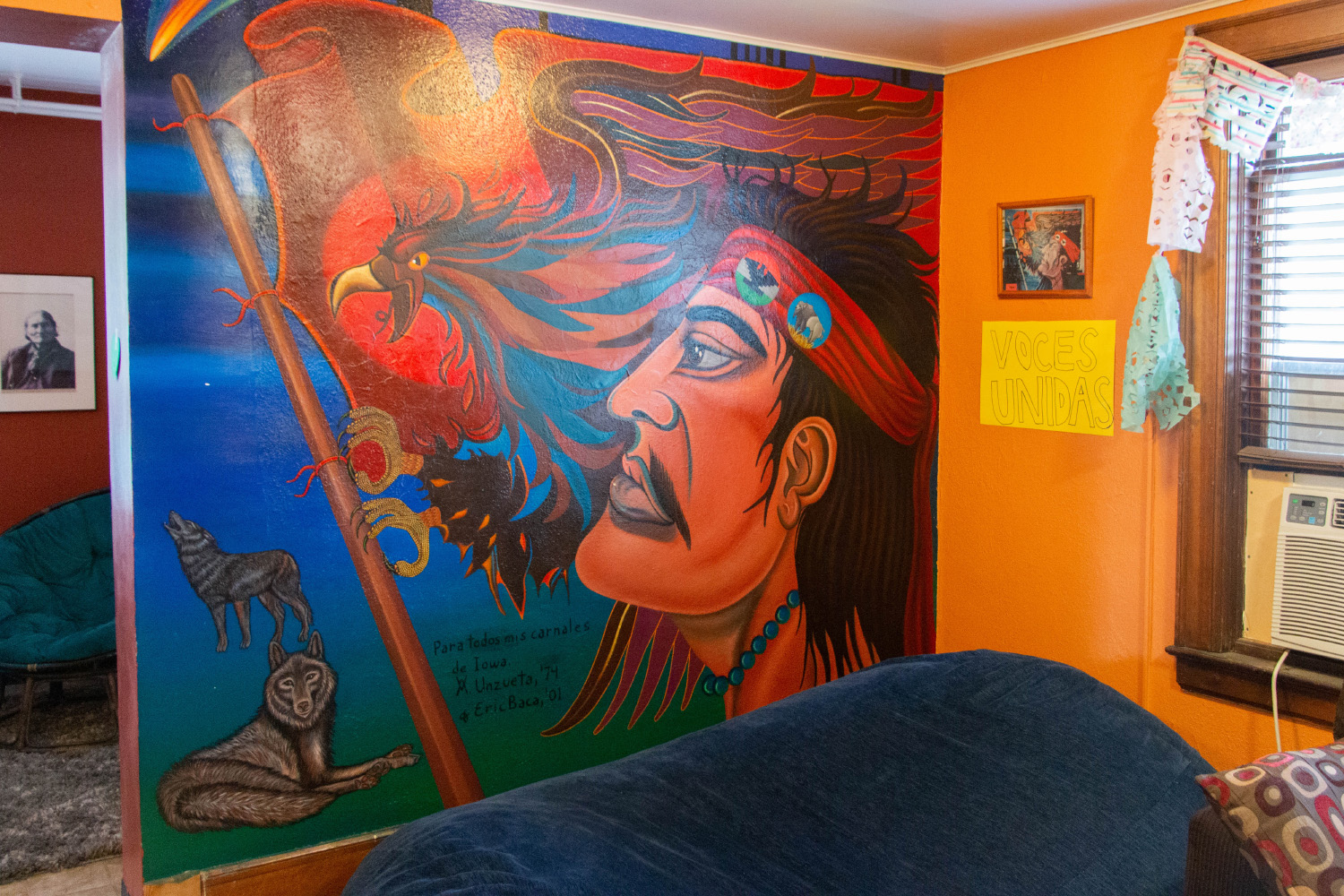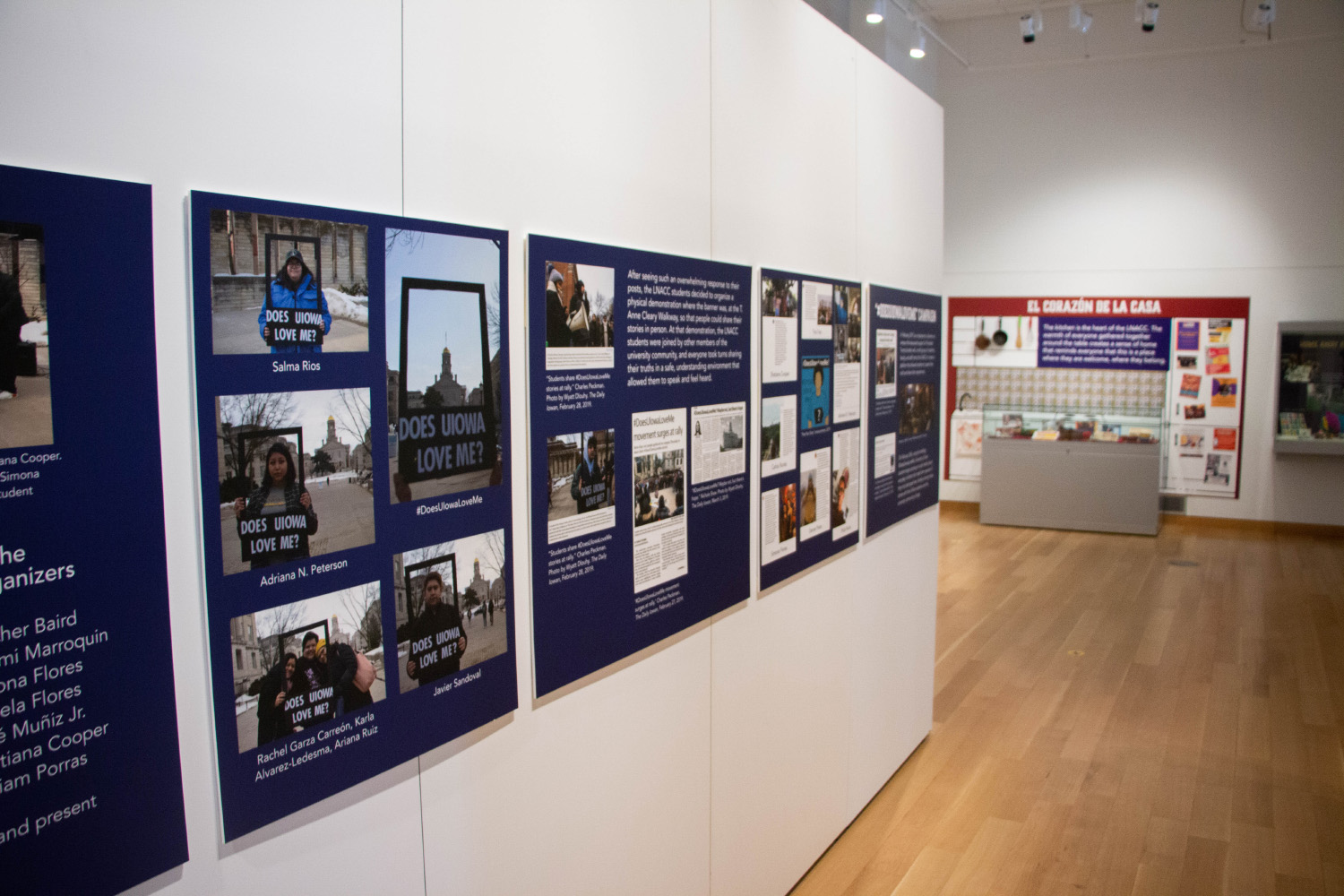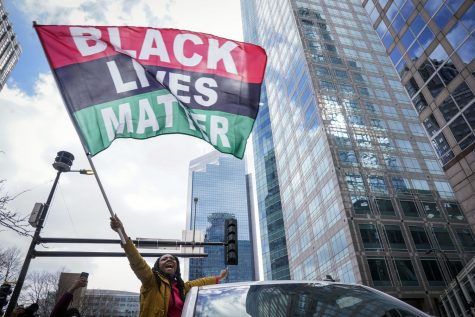‘You have a place’: Latinx and Native American students celebrate 50 years of the Latino Native American Cultural Center
For more than 50 years, the Latino Native American Cultural Center has provided a space for students to express their identity and connect with others.
April 20, 2021
When Isabela Flores transferred to the University of Iowa in fall 2015, she felt lost and challenged by the thought of making it through college on her own.
The first of her mother’s children to leave for college, Flores had toggled between different schools and spaces she felt comfortable in.
“I couldn’t quit school,” Flores said. “I was going to make it work here.”
Flores’ college experience changed after one quick Google search that led to a visit to the Latino Native American Cultural Center.
Walking into 308 Melrose Ave., she was greeted by a two-story house packed with students of many different identities. All it took for her to get involved was one person walking up to her and asking, “Hi, what’s your name?”
After that, Flores would return to the LNACC for years. It became a central hub to express her own identity and pay it forward by introducing herself to other students who would walk through the door.
Flores is not alone in finding a home away from home at the center. The space has provided students of Latinx and Native American identities a safe space to celebrate their identities since 1971.

Items from the Univeristy of Iowa’s Special Collections and University Archives are seen as part of a collection honoring the 50th anniversary of the Latino Native American Cultural Center.
A home is formed
More than 50 years ago, three UI students noticed a lack of people on campus with identities like their own. Nancy “Rusty” Barceló, Antonio Zavala, and Ruth Pushetonequa came together and traveled across Illinois and Iowa, in hopes of bringing more Chicano and Indian American students to the university.
For Barceló, the idea came to her as a UI graduate student in 1969. She was considering dropping out because she was one of few people who shared her identity and upbringing on campus. Her mother had sent her a care package of traditional Mexican treats like pan dulces and chorizo. She missed the food and people she saw daily at home.
While sitting in the UI registrar’s office waiting to drop out of school, she spotted a brochure on the ground for the Educational Opportunities Program.
“I thought to myself, ‘Why am I the only one?’” Barceló said.
In her time at Iowa, Barceló had not met many other students of Latinx or Native American identities. This changed when she met Pushetonequa and Zavala.
Zavala said the three were radically influenced by civil rights leaders fighting injustices, including the death of Martin Luther King Jr., Cesar Chavez’s dedication to helping farm workers, and students at Columbia University protesting their administration.
In a Daily Iowan article from 1971, Zavala and Pushetonequa said they hoped to establish a counterpart to the Afro-American house that was created in 1968. The founders had hoped to show films on campus and bring theatrical groups that would display their cultures.
“When I got to the University of Iowa, I started looking for the few Mexicans that were around,” Zavala said.
One month, Zavala organized a party in his dorm for the then-named Chicano and Indian American Student Union, hoping to bring together people of similar identities. After getting everyone on board, the students applied for a formal chartered organization status on Nov. 6, 1970.
The goal was to preserve the heritage and identity of Chicano and Indian American students on campus. According to a DI article from 1970, Zavala estimated there were 22 Chicano students and 14 Indian American students on campus at the time and believed there were more.
As the group continued to grow, the UI reported the addition of more dormitory advisers from underrepresented backgrounds in 1972. According to a 1972 DI article, around 10 Black students, one Indian student, and one student with a disability were hired as dormitory advisers.
The students would meet at 115 Clinton St., where the Spanish language department was located. By Oct. 4, 1973, they wanted their own formal house on campus. Under the administration of Willard “Sandy” Boyd, UI officials granted the space of 308 Melrose Ave. to the students of the Chicano and Indian American Student Union on campus.
The original Clinton Street building would later be torn down for new facilities at the UI. One piece of the original house would still follow the new building, however — a large wooden fireplace from the old house. The fireplace currently sits in a room on the second floor of the center, surrounded by rooms dedicated to affiliated student organizations with the LNACC.
The center faces Melrose Avenue, with a large walkway to a red-brick building resembling a typical family home. Inside, walls are painted a deep red, with chairs in almost every room. At the heart of the center is a kitchen with a fridge described as “always being full.”
Artwork and posters line the walls of both Latinx and Native American history that have accumulated over the years, with a mural prominently placed in the main living room. Manuel Unzueta created the mural in 1974. However, after many years of display, the mural began to deteriorate and was later restored by a local artist in 2001. The mural had lost the colors and original artist’s name, however, and this sparked controversy among many students at the time.
In addition to the new space, UI administration and students of underrepresented backgrounds spoke often in the early years of the center to continue the momentum of bringing more students of color to campus.
According to a 1973 DI article, 25 Chicano students met with then-Vice President for Student Services and Dean of Academic Affairs Philip Hubbard to request more out-of-state recruiting of students, use of the aid from the student support program, a Chicano faculty member, and a bilingual-bicultural UI Hospital and Clinics staff member to help break down barriers faced.
Every Saturday, a group of students of Chicano and Indian American backgrounds would go to elementary schools such as West Liberty to help children who were experiencing language barriers in the classroom, according to a 1973 DI article.
Recruitment of students with similar identities was key to continuing the momentum that they were building. Barceló would drive a university-provided van to areas in the Midwest to recruit students and the group would organize a “UIowa Chicano Conference” on April 26-27, 1974, entitled Nuestra Realidad, our reality.
“I’m surprised we all graduated,” Barceló said. “We were so committed to making sure others followed us to the University of Iowa.”
Early Voting
Iowa’s early voting period began on Oct. 19. Monday, Nov. 7 is the last day for in-person early voting.
Voters in Johnson County can vote at the auditor’s office’s administration building lobby, at 913 S. Dubuque St., or do drive-thru voting at Health and Human Services Parking Ramp, 855 S. Dubuque St. These options are available from 8 a.m. to 5 p.m. on weekdays in the early voting period. The weekend before election day these options will also be available 9 a.m. to 5 p.m. on Saturday Nov. 5 and 9 a.m. to 3 p.m. on Sunday Nov. 6.
Johnson County also offers several satellite voting locations where voters can cast ballots early during select days of the early voting period.
Map by Ryan Hansen/The Daily Iowan
Remaining Early Voting Locations
Where: Tiffin City Hall, 300 Railroad St., Tiffin
When: Tuesday, Oct. 25, 7 a.m. – 1 p.m.
Where: Iowa City Public Library, 123 S. Linn St., Iowa City
When: Sunday, Oct. 30, 11 a.m.- 5 p.m.; Monday, Oct. 31 through Nov. 2, 10 a.m. – 4 p.m.; Thursday, Nov. 3, noon - 6 p.m.
Where: Coralville Public Library, 1401 5th St., Coralville
When: Saturday, Nov. 5, 10 a.m. – 4 p.m., Sunday, Nov. 6, noon – 4 p.m.
Where: North Liberty Community Library, 520 W. Cherry St., North Liberty
When: Saturday, Nov. 5, 11 a.m. - 5 p.m., Sunday, Nov. 6, 1 p.m. – 4 p.m.

A mural in the Latino Native American Cultural Center is seen at 308 Melrose Ave. in Iowa City, IA. The mural was restored in 2001, but lost its original colors and the original artist’s name. Established in 1971, the center celebrates its 50th anniversary this year.
Maintaining the momentum
As the years went on, the movement to bring more students of underrepresented identities to campus continued.
During a weekend event on Aug. 27, 1994, the original name of the center was changed to the Latino Native American Cultural Center (LNACC), reflecting the varied cultures, languages, or tribal affiliations of both cultures.
“They called me before the change,” Barceló said. “I just asked that the sign always says it was founded by Chicano and Meskwaki students.”
When Tracy Peterson, former UI College of Engineering diversity and outreach programs director and citizen of the Diné (Navajo) Nation, arrived at the UI in fall of 1993, he began to embrace the opportunities around him. He took part in different science programs and played rugby. He would also meet his wife during his time at the UI, all while engaging with the LNACC.
During his time, Tracy worked closely with the Native American Student Association, connecting with older students and students that came after him to maintain the sense of community, using the LNACC as a support space.
The DI reported in 1999 that students were concerned about a UI proposal to move the cultural centers to a combined location in the Iowa Memorial Union. Because of student opposition, however, the centers remained in their spaces on the west side of campus.
“The LNACC was the integral connection to facilitating our connection,” Tracy said. “It was a place we could go to disconnect from the larger campus.”
When he began master’s degree at the UI, Tracy was offered a manager position at the LNACC, with hopes to bring more professional development opportunities to the position. Meanwhile, his daughter, Adriana Nazhone Peterson, would accompany her parents to the LNACC for dinners and other events.
For Adriana, a citizen of both the Diné (Navajo) Nation and the Menominee tribe and a transfer student currently at Penn State University, the LNACC was one of the key reasons she attended the UI at the start of her undergraduate career in fall 2016. She recalls being one of the kids in the 90s and early 2000s running around the house with other children of students.
“This is a culture, and it will open its arms,” Adriana said. “It was a family environment … It’s a different type of environment.”
Adriana remembers the space quite differently from what it looks like today — she recalls old red couches that used to sit in the LNACC living room and how much she used to love to sit around with friends in that room.
“The red couches were a true experience to take a nap on,” Adriana said, laughing.
In fall 2019, Adriana, Tracy, and her mother Nicole would move out to Penn State University.
Ttakimaweakwe Keely Driscoll, a member of the Meskwaki (wolf clan) with ties to the Winnebago tribe of Nebraska (Ho-chunk), was also one of the LNACC children who could remember Thursdays in the house while her mother was getting her master’s degree through the UI. Driscoll is the current president of the Native American Student Association and a third-year student at the UI.
She remembers some of her first Powwow experiences and witnessing firsthand the organization and feelings of togetherness.
“I felt this was an event that valued and honored the culture,” Driscoll said.
The UI Powwow, founded in 1990, highlighted beautiful dances of Native American culture and different traditions. It was a time for celebration and honoring Native American identities and tradition. The UI Powwow has hosted more than 350 dancers, 18 drum groups, and 60 arts and crafts vendors.
According to the Powwow website, the Chicano Indian American Student Union held smaller gatherings where Native American dance was one of many symposium topics. In fall 1989, the American Indian Student Association was founded by Orrenzo Snyder (Diné), Larry Lasley (Meskwaki), Alex Walker (Meskwaki), Judy Morrison (Osage), and Stephanie Griffith (Dakota), all of whom are now UI alumni.
By fall 2013, students decided to change the name to Native American Student Association (NASA) to better fit with the changing times.
A land acknowledgment was also created in October 2020 to show respect toward Indigenous peoples and recognize that the UI is located on the homelands of tribal nations. It was formed as an expression of gratitude by the UI Native American Council and is supported by many at the UI.
The centers and their programs have been funded through various channels including General Education Funds, the Student Activity Fee, and other external sources to continue to improve the centers. In fiscal years 2016 and 2017, UI President Bruce Harreld approved central funds of $200,000 to go towards renovations and upgrades in the centers. An additional $50,000 was allocated in fiscal year 2018 to finish the projects. Also, the centers have received $40,000 from the Student Activity Fee for the past three fiscal years, along with the ongoing general education funds the centers receive. In fiscal years 2022-2024, pending state Board of Regents approval, the centers will receive $45,000 each year from the Student Activity Fee. These figures do not include the General Education Funds that are allocated for the salaries and fringe benefits of the professional and scientific center staff.

The Latino Native American Cultural Center exhibit is seen in the main library gallery in Iowa City, IA. Established in 1971, the center celebrates their 50th anniversary this year.
Honoring 50 years of family
Just to the right of the Shambaugh Auditorium in the UI Main Library sits the LNACC exhibit, “Building Our Own Community: 50 Years of the Latino Native American Cultural Center, Founded by Chicano and American Indian Students in 1971.”
The exhibit, curated by Rachel Garza Carreón and Christopher Ortega, holds artwork, newspaper clippings, and items from the last 50 years. Sweeping quotes occupy the beige walls, once spoken by the three founders and others who influenced the center’s creation.
For Garza Carreón, coming to Iowa from San Antonio, Texas, made her long for her Chicana-Tejana roots and miss her culture’s traditions and foods. The LNACC was where she felt at home.
“You don’t have to explain yourself,” Garza Carreón said. “Whatever part of Latino and Native American culture you are — you have a place.”
An important piece of the history Garza Carreón said was the #DoesUIowaLoveMe movement in February 2019, during which students, staff, and faculty took to social media to share their concerns about discrimination on campus. Support came in the form of tweets, Instagram posts, and stories shared at a rally on the T. Anne Cleary walkway.
The exhibit will be open until late July for the students to visit in the Main Library Gallery.
Jessica Padilla, co-president of the Latino Native-American Alumni Alliance (LANA3), said maintaining the involvement of students is important after they graduate and leave the UI. The pandemic has created opportunities to make connections virtually and attempt to think about how to continue to foster that sense of community.
“The older you get, the more responsibilities you get,” Padilla said. “We just hope to continue to be a resource for our students.”
The Native American Student Association hosted its first-ever virtual event on April 17, entitled, “Honoring the Powwow at the University of Iowa.” The Powwow was canceled due to COVID-19 in 2020. The 26th annual Powwow looked a little different for 2021, but still honored those who continued to support the community. Similar to the 14th annual Latinx Week in Action held in March and Latinx/a/o Heritage Month for 2020, the events were held in an entirely virtual format because of COVID-19.
The LNACC will celebrate throughout 2021 with various events and virtual programming pending updated public health recommendations during the pandemic.
First-generation and Guatemalan American student McKrina Lopez serves as the student lead for the LNACC, alongside Coordinator Isabela Flores. Although the center’s “home away from home” feelings have drastically changed because of COVID-19, she still feels like there are different avenues to maintain the connection with students and celebrate this year.
“We are trying to keep relationships as best we can,” Lopez said. “… It has definitely been a challenge.”
Flores and Lopez continue to work hard with their peers to drive programming and the sense of community in a home that has such a wide range of history to it. They continue to uphold the values and recognize the importance of the center’s story from Barceló, Zavala, and Pushetonequa.
And even today, the originators feel a strong connection with the center.
“The cultural center,” Barceló said, “we affectionately called it, La Casa, our home.”



